Last week I presented Mrs Lockett Agnew (nee Augusta Isobel Sheil), in an 18th c. inspired 1880s reception ensemble. There were a few tiny niggles about the very high neck, or the top-buttoning only jacket, but generally you thought it fabulous, and even if you didn’t like it personally, you thought it was perfect for Augusta, giving it a smashing 9 out of 10 (basically anything above a 9 is a perfect score these days!).
This Week’s Rate the Dress dress shows the transition from 1830s to 1840s fashions. The more elaborate sleeves and scalloped edging looks back to the cluttered detailing of the Romantic era, but the overall silhouette of the dress follows the smoother, sleeker line of the 1840s.
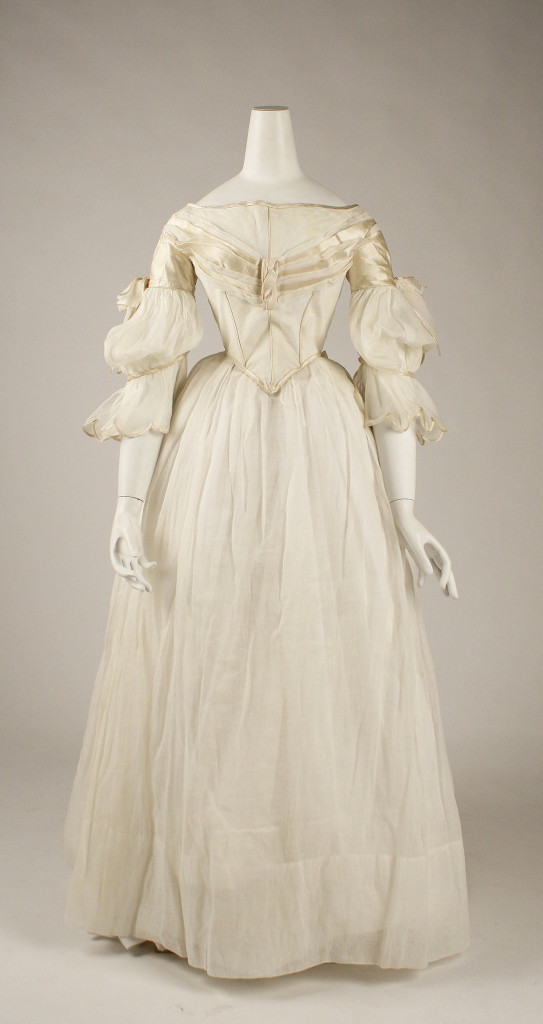
Evening dress, ca. 1840, American, cotton, silk, Metropolitan Museum of Art, 1982.132.1ab
Made from a stiff cotton tarlatan, with details in silk satin, the dress uses the shine of the satin weave to highlight and define the detailing, while keeping the an overall simple, monochromatic ivory.
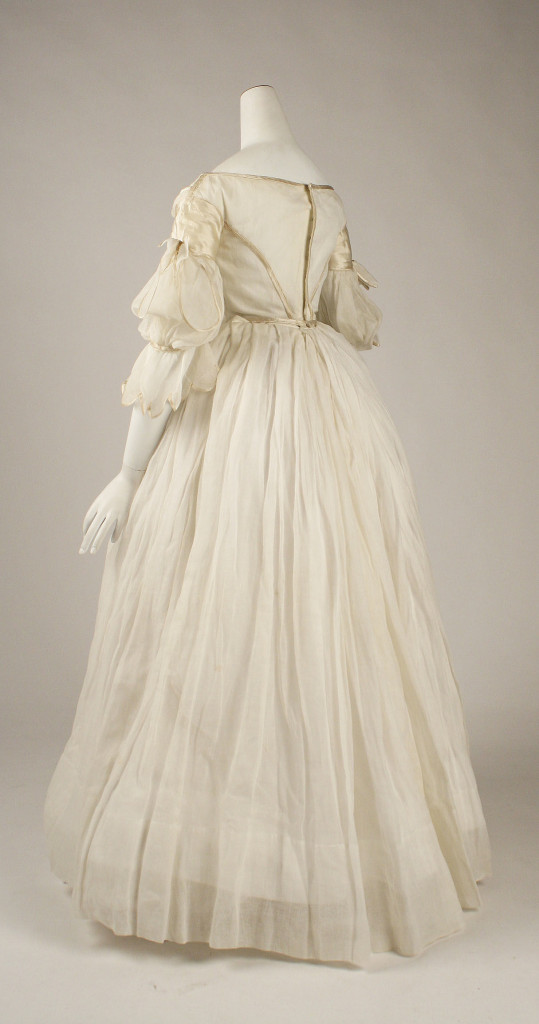
Evening dress, ca. 1840, American, cotton, silk, Metropolitan Museum of Art, 1982.132.1ab
While this may have been a wedding dress, white was also a very popular choice for evening dresses, particularly for young women (think of Meg, two decades later, taking her tarlatan to wear to the Moffat’s ball, where she would “look like an angel in white” according to Amy).
White was symbolic of youth and purity (as much, if not more, in a general sense, in that a young girl would be unsullied by the experience of life’s woes and cares, than a specific, literal, virginal sense), and brighter, deeper colours were considered too worldly and sophisticated for younger women.
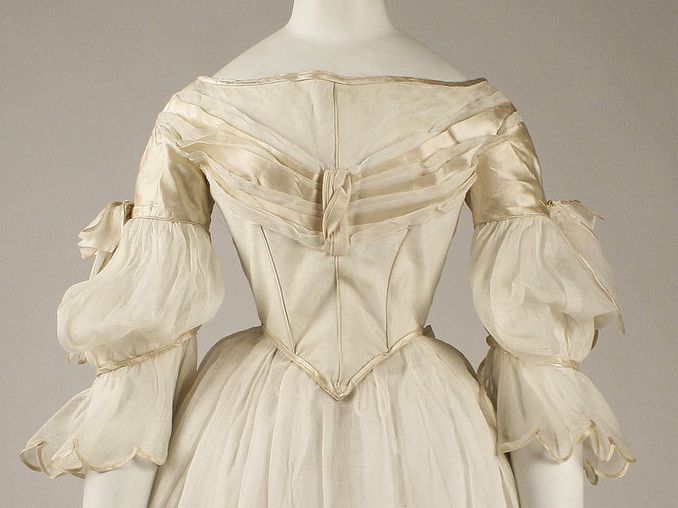
Evening dress, ca. 1840, American, cotton, silk, Metropolitan Museum of Art, 1982.132.1ab
The cut of the bodice, with a slightly higher neckline, and the softly drooping puffed sleeves add to the impression of youthful girlishness, but the dress shows a distinct sophistication in its execution, if not the intent of its design – it’s clearly the work of an experienced seamstress.
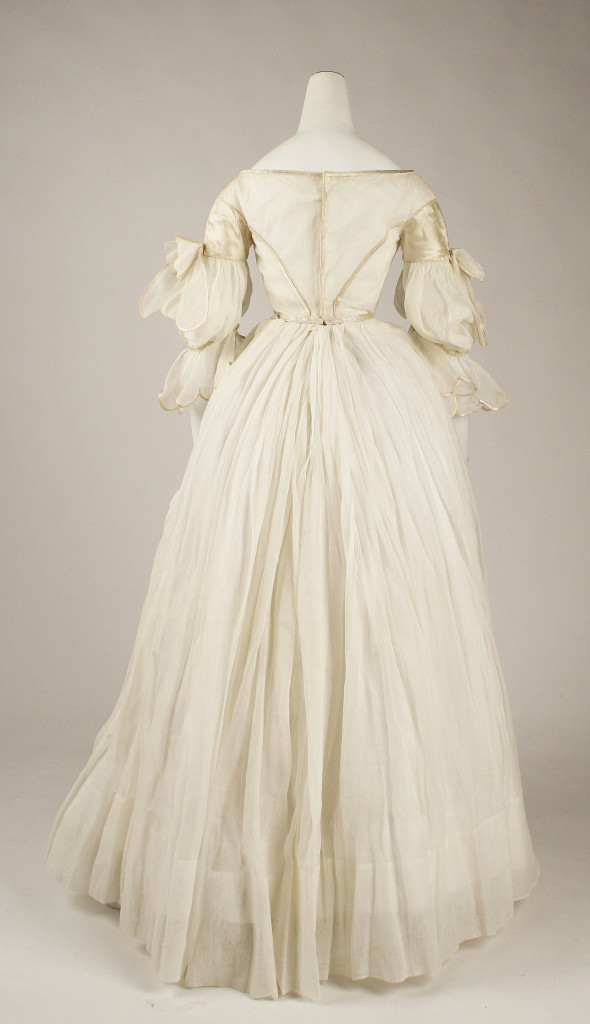
Evening dress, ca. 1840, American, cotton, silk, Metropolitan Museum of Art, 1982.132.1ab
Beyond ideas of youthful purity, white was a popular choice for evening dresses because it was so effective – in an era of dim nighttime lighting, a light coloured dress would stand out more in a candle-lit room.
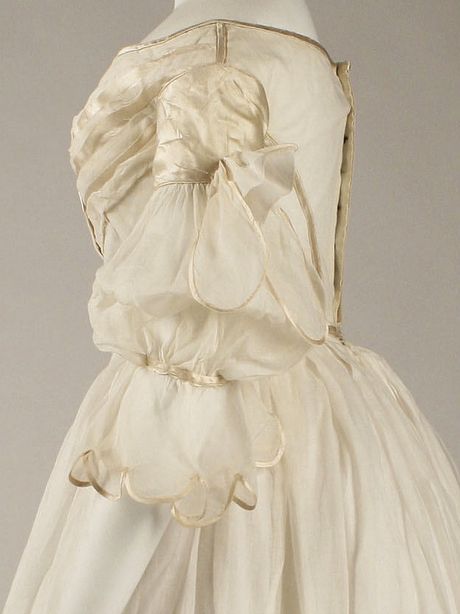
Evening dress, ca. 1840, American, cotton, silk, Metropolitan Museum of Art, 1982.132.1ab
In this dress, the satin areas would catch the light even more, highlighting the painstaking trimming on the seams (piped seams and seam trim), around the scalloped sleeves edges, and on the sleeve bows.
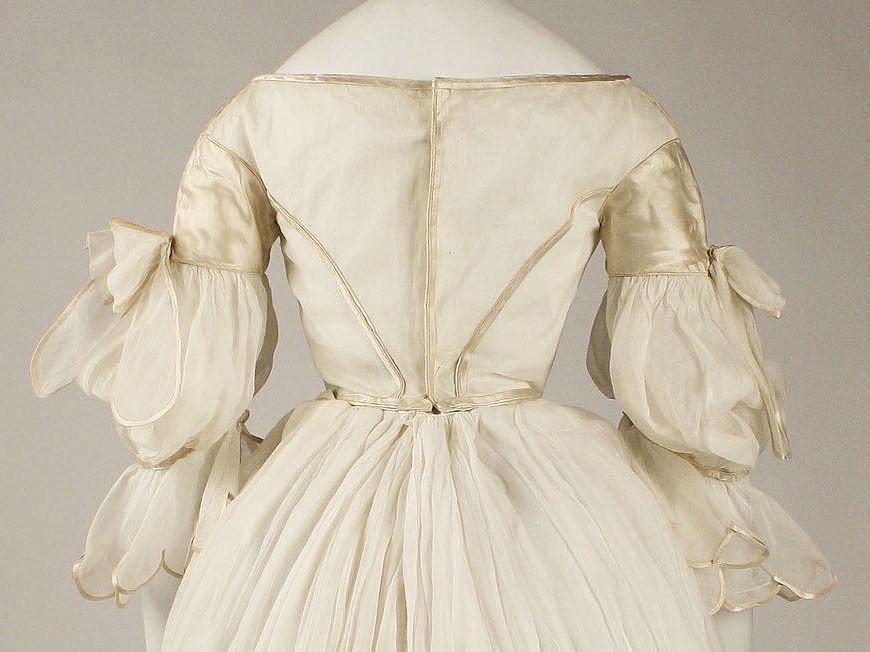
Evening dress, ca. 1840, American, cotton, silk, Metropolitan Museum of Art, 1982.132.1ab
What do you make of the mix of girlish details, sophisticated sewing, and simple colours?
Rate the Dress on a Scale of 1 to 10

I adore this dress – just tuck it up a little and any of the great romantic ballerinas could have worn it to play the part of a young, sylph-like beauty, dancing over the shimmering, moon-lit moors, waving her arms about gracefully and bewailing the death of her devilish demon lover…it is the genuine romantic dream. (not the devilish demon lover thing, but the dress! THE DRESS!)
The dress is much less fun and naughty than the diaphanous “naked dresses” of previous decades, rather more demure and sweet – but still cleverly made, the knot thingie highlighting the heaving bosom below is slightly strange, but still! Perfection!
10/10 (and I’ve never rated a dress with 10/10)
I’ve always loved the waistline that comes to a point, and the froth of the skirt and sleeves are a beautfully sutble contrast to the sheen of the bodice. It manages volume without bulk. 10 of 10
It’s beautiful. It would be perfect if it made a clear choice on its neckline. But it didn’t. Instead it tries to eat its cake and have it too by doing two very different ones at once. The result is flawed.
I also am not a fan of the duo-tone of the two fabrics but I strongly believe that originally they must have matched perfectly and what we see here is different fabrics aging in different ways, not the original intent of the dressmaker.
9/10
You managed to pick one of my favourite dresses. There’s a Czech historical novella/novel/whatever in which the young heroine (who’s in a bit of a Cinderella situation) is described as feeling overwhelmed by her highly fashionable, richer cousin’s dress when getting prepared for a ball in a dress she’s sewn herself, but unknowingly being very pretty herself in her innocent youthful beauty, “like a lilly-of-the-valley”. And this dress would fit that description most beautifully. That ball actually takes place in the winter of 1847/48, so a bit later than this, but I just can’t help but see her in it now that I know of this dress! Those sleeves are so perfect. And there’s just the right amount of shiny texture with the satin to add some definition, without going overboard with it and overwhelming that soft look of the other, sheer-ish fabric.
So, as you can guess, that’s 10/10 from me. 🙂
This is one of my favourite periods of fashion history, so you’ve chosen a dress that I really am prepared to admire! So pretty, innocent and playful, yet cleverly cut and painstakingly detailed. The delightful knot at the front caught my attention particularly; there’s so much to see and enjoy on this gown. 10/10
10/10
I love silhouette, the shape of the neckline and sleeves, and the satin detailing. And I agree that in candlelight, the difference in texture between the tarlatan and the satin would almost give a two-color effect. Although I get the fact that white was a popular ballgown choice for very young women, the dress still seems a bit *too* understated to me in white-on-white. So I’d give it a 9.5.
It’s a mystery on how she got into the top. Tiny buttons or hook & eye under the center back seam? Other than that it is perfection! 10/10
There’s definitely a back opening: it’s clearly seen in the side photo.
Thank you!
Not my favorite era, but still a wonderful dress. Those sleeves are fantastic. I don’t like the vertical braided loop (?) on the bodice – the dress doesn’t need anything overwhelming, but I don’t think that loop is a very good focal point – but that’s about it. As with last week’s dress, I’m still not pushed into LOVE IT territory, but those are great sleeves, and the whole effect is airy without being over the top.
(And I enjoyed learning how the dress would have been perceived/shown to advantage during its time.)
8.5/10
I love this so much! 10 out of 10. Perfect in every way — especially the satin seams.
I love it, too! 10 out of 10.
Something so simple, but with all that satin trim to give richness, and to play with the light.
One thing I was thinking of, that you, Dreamstress, might be able to tell me – what was the tradition in the USA of girls being debutants? In NZ, young women were presented to bishops, mayors, all sorts of important people, and for these occasions they mostly wore white dresses. This dress is older than the opportunity to be a deb in New Zealand, but might it have been possible to be a debutant in the US at this time, wearing something like this?
I am not a fan of white but this dress is beautiful. 10/10.
I love it, can’t really find anything bad to say about it so it’s 10 out of 10 from me.
I love it 9/10. As for the neckline, I think the lower option was the original idea and then Mama or Grandmama (or Someone) said, no, cover that up, so that extra bit was added. It just doesn’t seem like it fits.
I had the same impression.
One sees the grandmother of the Dowager Duchess pulling herself up to an impressive height and saying, coldly: “HWAT is the meaning of that?” – followed by the cowering seamstress quickly (and tremblingly) pinning the extra bit on. (And the owner of the dress secretly pouting a lot. )
I’m going to spoil the prevailing opinion and say Meh.
Yes, it’s very well executed, but even with all the satin and floofs it’s just a bit too much of a wallflower. The eye passes over it and moves on. 5/10
Just what I was thinking! I’m certain most ballrooms would have been filled with young ladies in pretty white dresses like this, and you wouldn’t stand out as such, I think. 7/10
Oh good, I’m not the only one…
This is my favorite era. I wish it were a color, but you managed to make white sound like a good choice. I love the neckline. I like the coverage the high neckline gives along with the interest of the lower pleated section. 9/10
I love it. I definitely prefer the 1840s to the 1830s, but this brings just the right amount of fantasy and froof to the restrained lines of the later period.
10/10
This is a very sweet dress for a young woman. I’ve always been iffy on the droopy shoulders because I inherited my Father’s and Mother’s square shoulders (I hardly needed to wear shoulder pads ;-)!). For me the seamstress would have had to make a redesign. (BTW, I love the sleeves. YUUM!!) So, for all those women who did not have sloping shoulders I’ll rate this with an 8.5/10
A lovely dress, I can find no fault with it.
10/10
I adore this dress. Elegant, stylish, and reminds me of a flower fairy 🙂 I just love the sleeves! 10/10
10/10 – stunning, breathtaking… Timeless in its juxtaposition of detail and simplicity.
I am going to overlook the droopy bows on the sleeves. This is 10/10… could it be an 11? Bonus point, because I want to wear it.
10/10
Have been researching this fashion style for a possible project. This bodice in terms of bertha, neckline, waist and the piping (back and front) its identical to a lovely day dress I’ve been looking at from the same period.
I love it, the shape is nice, the colour is not stark white making it wearable by most. 9/10
6/10. It’s lovely and probably hasn’t aged perfectly, but even allowing for that, I feel it could have stood a bit more fuss – this kind of lovely monochromatic design is one that begs for just a little bit more frou frou, such as a flounce around the hem or some scallops – as it is, it looks a tiny bit top heavy. It’s also not really terribly exciting to look at – very pretty, but not an awful lot to go “oooh” at – somehow it merges into the background (probably a photography judgement error). It is pretty, but insipidly so – a nice little dress for a nice little gel who’s had an emimently suitable personality vascetomy.
I’m a sucker for monochromatic anyway, but the sleeves on this one really got me. I usually don’t like style of V-point bodice or this era in general, but there is something so sweet about the piping details and play between sheer and satin. It’s so romantic and beautiful without being overdone. I don’t mind the neckline on this mannequin, but I wonder if it would be distracting when worn.
8/10 – (It would have gotten a 9 if only the hem were scalloped and piped!)
While the 1830’s don’t thrill me in general, I do like these transitional styles. Although the dress looks a bit “blah” on a mannequin, I think it would have been lovely when worn. The satin contrast would have definitely shone in candlelight. And, given the fashion preferences of the time, it would probably have been a hit – simple beauty without a hint of scandal. 10/10.
The braided trim on the neckline has got to go! It’s the first thing I saw and it took the pleasure out of my first impression. -5
I can see the pretty tails on the bows, but I can’t see the bows, they’re not to scale with the tails. They just need to be big enough so that you can see what they are. -5 …..the tails made me think of floppy, sweet, puppy dog’s ears ; )
The satin edging around the scallops is amazing and it also adds elegance to the bodice. It would’ve been fun to see a closeup of that work. Those sleeves are exquisite. It would be nice to see scallops somewhere on the skirt, but not having them doesn’t take away from the dress.
Overall it’s a very, very pretty little dress. 9/10